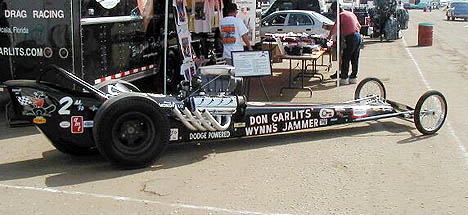Tire & Header Aero Musings
By Vic Cooke

Did Don Garlits' zoomie headers push the dirty air out of the way of the slicks?
Photo by Vic Cooke
Seeing swamp Rat VI at CHRR a few weeks ago brought back a lot of old memories...the first 200 mph record run, the win at Indy '64 (the first major race with nitro I ever saw), etc. I looked that car over closely several times, refreshing my memory on the details like that flat plate deflector over the front axle and the exact geometry of the zoomies. You can see these both in the attached picture. This was also that car that launched the zoom-header revolution, (remember that? It happened even faster than the RED revolution!) as the zoomies were given much credit as a key element enabling the breakthrough beyond 200.
In his bio, Garlits gives equal parts credit to some engine changes that he made, a set of new-compound M&H tires that Marv had developed to one-up Goodyear, and the zoomies (which he acknowledges copying from Frank Cannon, who was also running at or just over 200 mph with them). Garlits felt the main contribution of the zoomies was in heating the tires and making them stickier
down track. Others thought it was the effect of the exhaust stream cleaning the "pills" of sheared rubber off the softer slicks and permitting a cleaner tire contact with the pavement. Minor note was made of the down force added by the sharply upswept design, and in retrospect, this may have been the really key factor.... permitting just enough additional tractive thrust to benefit acceleration over the tire-smoking portion of the run, then keep it coupled for the final burst of speed.
There's one other possible advantage that I've pondered for years and years without ever finding an answer one way or the other. Specifically, I've wondered whether the high-velocity and expansive wall of header flame in front of the slicks works as sort of an aerodynamic "cloak" that deflects the atmosphere that would otherwise create drag against those big fat drag slicks. Things seem to point that way, but I just don't know.
A couple years later I remember a photoset in HRM and on the Hot Rod Annual with Kalitta's Logghe/SOHC-Ford dragster in a wind tunnel at Ford, showing the header flame pattern bent around the tires. Couldn't help but wonder if somebody had a simple load cell hooked to that car measuring drag, and if they fiddled with the simple adjustables that might affect drag. Wondered, but never found out. I'm sure the data has to exist somewhere from somebody's dragster in a wind tunnel, but it's just the sort of techno-morsel that never seems to find the light of day. However, it just MIGHT be that it's no morsel at all, and could be that some clever thinking on use of the exhaust stream on a modern FED could render aero wonders!
So, if I had a wind tunnel <wide evil grin> I'd play around with stuff like a inboard to outboard stagger on the zoomies to broaden the flow path and see if that affected anything, maybe try a deeper drop and lower dump point to see what that did, and maybe check out various options on tubing configuration and angling affecting down force.
Hmmm. Maybe there's another way... Maybe someone can ask Techno-Tim Gibson sometime if any of this drivel makes any sense. At least it would set my hyper-curiosity to rest, one way or the other, LOL!
Vic Cooke
diggervic@yahoo.com